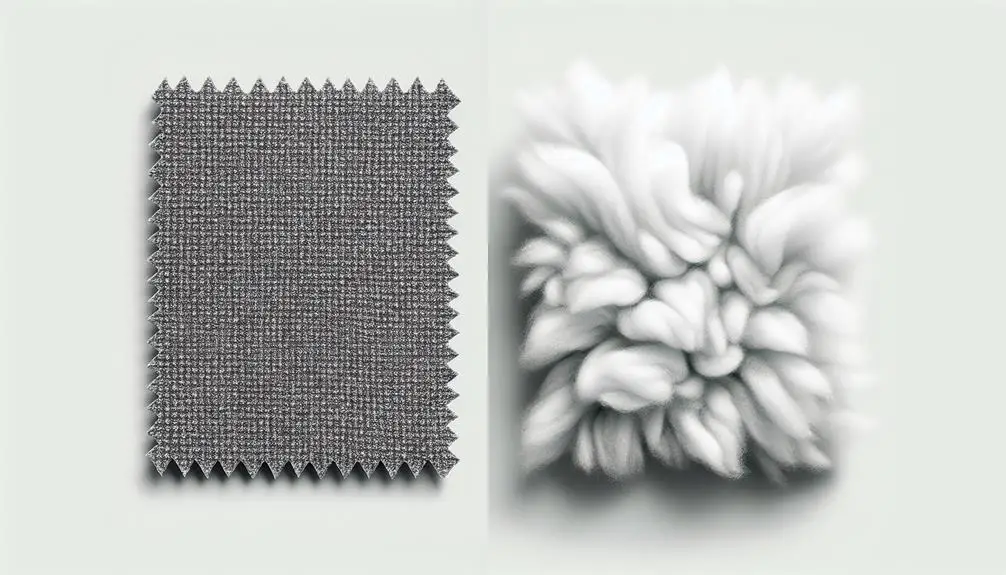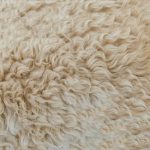Let's unravel the mystery of microfleece versus fleece. Picture this: you're standing in front of two cozy fabrics, one with finer strands and the other a tad thicker.
Ever wondered which one would keep you warmer without weighing you down? The distinction goes beyond just thickness, delving into breathability and moisture-wicking abilities.
Curious to find out which fabric might suit your needs better?
Table of Contents
Key Takeaways
- Microfleece offers lighter insulation and breathability, ideal for warm weather activities.
- Fleece provides superior warmth and durability, suitable for cold environments.
- Microfleece excels in moisture management and quick drying during active pursuits.
- Fleece surpasses microfleece in longevity and wear resistance, reducing frequent replacements.
Key Characteristics of Microfleece
When it comes to the key characteristics of microfleece, its lightweight nature and exceptional warmth make it a favorite choice for various clothing and outdoor gear. Weighing typically 200 gsm or less, microfleece provides a comfortable and cozy feel without adding bulk. This makes it ideal for creating shirts, gym clothes, lightweight jackets, and blankets.
Despite its lightness, microfleece offers impressive warmth, keeping you snug in colder temperatures. What sets microfleece apart is its ability to wick away moisture, ensuring that sweat and moisture are pulled away from your skin, keeping you dry and comfortable during activities. This breathability also makes it a great option for layering, allowing you to regulate your temperature effectively.
Properties of Traditional Fleece
Traditional fleece, with its 100% polyester composition, boasts exceptional warmth, softness, and moisture-resistant properties. This fabric is adept at providing insulation by trapping body heat, keeping you warm and comfortable in cold weather.
The synthetic fibers in traditional fleece efficiently wick moisture away from the skin, preventing that clammy feeling often experienced with other materials. Its ability to keep you dry and cozy makes it a popular choice for various cold-weather garments like jackets, sweaters, and blankets.
Additionally, traditional fleece is known for its durability, making it suitable for outdoor activities where ruggedness is essential. Its machine washable and quick-drying nature adds to its practicality, allowing for easy care and maintenance.
Whether you're hiking in the mountains or simply running errands in the city, traditional fleece is a reliable option for staying snug and protected from the elements.
Thermal Insulation Variances
When comparing microfleece and regular fleece, it's crucial to understand how thickness affects warmth levels. The density of the fabric plays a significant role in determining its insulating properties.
Layering different fleece types can also enhance overall insulation.
Thickness Affects Warmth
In determining the warmth provided by different fabrics, the thickness of microfleece and fleece plays a significant role due to its direct impact on thermal insulation levels. Microfleece, being thinner than fleece, offers less thermal insulation, making it suitable for lightweight layering. Conversely, fleece, with its thicker composition, provides more warmth and is ideal for heavier insulation needs. The thickness of the fabric directly influences the heat retention capability, affecting how effectively it traps heat to keep you warm. Understanding these thickness differences is crucial in selecting the right fabric for specific warmth requirements.
| Thickness | Warmth | Thermal Insulation |
|---|---|---|
| Microfleece | Less warm | Lower insulation |
| Fleece | Warmer | Higher insulation |
Fabric Density Matters
The difference in fabric density between microfleece and fleece significantly impacts their thermal insulation capabilities, affecting how well they regulate body temperature. Microfleece, with a lower fabric density of 200 gsm or less, provides less thermal insulation, making it suitable for milder weather conditions.
In contrast, fleece, with its thicker fabric density, offers better warmth retention and insulation, ideal for colder climates and outerwear. Understanding these fabric density distinctions is crucial for choosing the right material based on the desired level of warmth and insulation needed.
Whether facing varying weather conditions or trying to maintain optimal body temperature, the fabric density of microfleece and fleece plays a key role in determining their thermal insulation effectiveness.
Insulation in Layers
For optimal insulation in layers, understanding the thermal variances between microfleece and fleece is essential. When considering the insulation properties of these fabrics, there are significant differences to note:
- Microfleece provides lighter insulation due to its thinner fibers.
- Fleece offers greater thermal insulation with its thicker construction, making it suitable for colder conditions.
- Layering Microfleece works well for moderate insulation needs, while Fleece serves as an effective primary insulating layer in harsh environments.
- The choice between Microfleece and Fleece for insulation depends on the desired warmth level and specific weather conditions.
Understanding the thermal properties of these fabrics is crucial for selecting the most suitable option to ensure optimal comfort and protection in varying climates.
Fabric Texture and Feel Differences
When comparing microfleece and fleece, the noticeable difference lies in the fabric's texture and feel. Microfleece stands out with its smoother texture compared to regular fleece. Its finer fibers give it a softer and more delicate touch, providing a luxurious and velvety feel against the skin.
On the other hand, fleece has a thicker and coarser texture, giving it a slightly fuzzy or fluffy feel. In contrast, microfleece feels silkier and smoother, enhancing comfort and sensation when worn or used.
These differences in fabric texture contribute significantly to the overall experience of wearing or using garments made from microfleece or fleece. Whether seeking a more delicate and velvety touch with microfleece or a coarser yet still cozy feel with fleece, understanding these texture disparities can help in choosing the ideal fabric for specific needs.
Durability and Longevity Contrasts
When comparing microfleece and traditional fleece, the durability differences become evident.
Microfleece's tightly woven structure and finer fibers contribute to its resistance against wear and tear.
This enhanced durability makes microfleece a long-lasting choice for those seeking lasting quality in their garments.
Wear and Tear
In comparing the wear and tear characteristics of microfleece and traditional fleece, it becomes evident that traditional fleece surpasses microfleece in durability and longevity due to its thicker construction and resilience against pilling.
- Durability: Traditional fleece is known for its robustness, making it more resistant to damage from regular use and washing.
- Longevity: The durable nature of traditional fleece allows it to maintain its quality and appearance over a more extended period compared to microfleece.
- Pilling: Microfleece is more prone to pilling, which can make it look worn out faster than traditional fleece.
- Wear and Tear: Traditional fleece's thicker fibers and construction provide better protection against wear and tear, ensuring a longer lifespan for the garment.
Stitching Strength
Moving from the comparison of wear and tear between microfleece and traditional fleece, the stitching strength in these fabrics reveals significant differences in durability and longevity. Regular fleece typically boasts stronger stitching than microfleece due to its thicker composition, offering more robust construction. This enhanced stitching in regular fleece makes it more resilient to wear and tear, especially in high-stress areas, compared to the finer stitching found in microfleece.
The durability of regular fleece's stitching makes it a preferred choice for heavy-duty or long-term use, ensuring a longer lifespan for the garment. In contrast, the delicate stitching of microfleece may be more susceptible to fraying and damage over time, potentially impacting its longevity.
Material Lifespan
Regular fleece outperforms microfleece in terms of material lifespan, showcasing superior durability and longevity due to its thicker fibers and robust construction.
When comparing regular fleece to microfleece in terms of material lifespan:
- Durability: Regular fleece is known for its durability, withstanding wear and tear more effectively than microfleece.
- Longevity: The robust construction of regular fleece contributes to its longevity, making it a reliable choice for long-term use.
- Thicker Fibers: The thicker composition of regular fleece enhances its ability to maintain quality over time, ensuring a prolonged lifespan.
- Maintenance: Regular fleece typically requires less frequent replacement compared to microfleece, making it a more sustainable option in the long run.
Best Use Cases for Each Fabric
When considering the best use cases for microfleece and fleece, it's important to understand their distinct properties and advantages.
Microfleece, known for being lightweight and breathable, is perfect for warm weather and outdoor activities. Its ability to wick moisture away quickly makes it an excellent choice for active pursuits where staying dry is crucial.
On the other hand, fleece shines in cold weather conditions, providing exceptional warmth and insulation. This makes it a go-to option for winter clothing, ensuring coziness even in the chilliest of environments.
Whether you're hiking in the mountains or strolling through a snowy city, the choice between microfleece and fleece ultimately depends on your specific needs and preferences. Both fabrics offer unique benefits tailored to different situations, so selecting the right one can enhance your comfort and performance based on the weather and activities you'll be engaging in.
Frequently Asked Questions
What Is the Warmest Type of Fleece?
Heavy-weight fleece stands out as the warmest type due to its dense construction. It offers superior insulation, perfect for extreme cold. Microfleece, being lightweight and less insulating, falls behind heavy-weight and textured fleece in warmth.
Is Microfleece Good Quality?
Microfleece is excellent quality, known for its softness, durability, and moisture-wicking properties. It's popular in activewear for its comfort and flexibility during physical activities. Many top brands offer reliable microfleece products for outdoor pursuits.
What Does Microfleece Feel Like?
It feels soft and smooth, with fine fibers creating a luxurious, plush texture. Lightweight and cozy, microfleece offers gentle warmth without bulk. Its velvety surface is soothing, perfect for lounging or outdoor activities.
Is Micro Fleece Good for Winter?
Absolutely, microfleece is a winter superhero! It's lightweight, warm, and perfect for outdoor adventures. It keeps me cozy without feeling bulky, making it my go-to choice for staying toasty during the cold season.
- Tetron Fabric for Footwear: Style and Durability Guide - June 17, 2025
- Tetron Fabric for Automotive Applications: Durability and Performance - June 17, 2025
- Tetron Fabric for Home Textiles: Uses and Benefits - June 17, 2025







